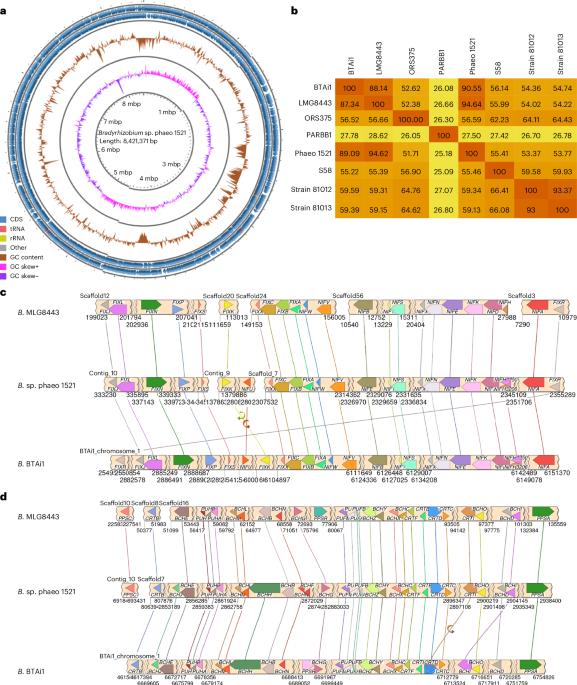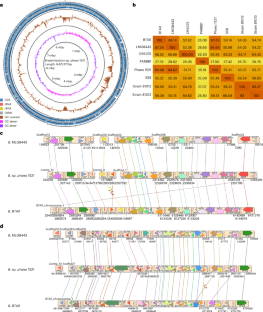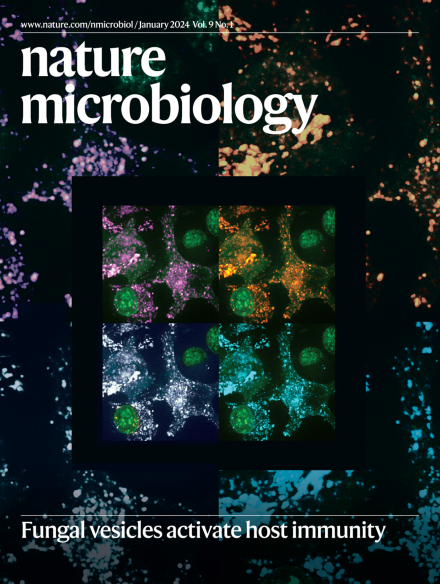从海洋硅藻中分离出的缓生根瘤菌在陆生豆科植物中诱导固氮结核
IF 19.4
1区 生物学
Q1 MICROBIOLOGY
引用次数: 0
摘要
生物固氮将大气中的氮转化为氨,这对全球氮循环至关重要。虽然蓝藻重氮营养体的特征很好,但最近的研究表明,在海洋环境中,非蓝藻重氮营养体(NCDs)分布广泛,尽管它们的研究受到可培养性差的限制。在这里,我们报告了一个以前未被鉴定的从海洋硅藻褐指藻分离的缓生根瘤菌。系统基因组学分析将该菌株置于光合迟缓根瘤菌中,表明对海洋和陆地生态位的进化适应。平均核苷酸身份支持其分类为以前未被描述的物种。值得注意的是,接种实验表明,该菌株在豆科植物中诱导了固氮根瘤,表明其具有跨生态边界的共生能力。泛基因组分析和代谢预测表明,该分离物与陆生光合慢生根瘤菌比与海洋非传染性疾病具有更多的特征。总的来说,这些发现表明共生相互作用可能在不同的生态位中进化,并提出了关于固氮和微生物-宿主相互作用进化的问题。本文章由计算机程序翻译,如有差异,请以英文原文为准。


A Bradyrhizobium isolate from a marine diatom induces nitrogen-fixing nodules in a terrestrial legume
Biological nitrogen fixation converts atmospheric nitrogen into ammonia, essential to the global nitrogen cycle. While cyanobacterial diazotrophs are well characterized, recent studies have revealed a broad distribution of non-cyanobacterial diazotrophs (NCDs) in marine environments, although their study is limited by poor cultivability. Here we report a previously uncharacterized Bradyrhizobium isolated from the marine diatom Phaeodactylum tricornutum. Phylogenomic analysis places the strain within photosynthetic Bradyrhizobium, suggesting evolutionary adaptations to marine and terrestrial niches. Average nucleotide identity supports its classification as a previously undescribed species. Remarkably, inoculation experiments showed that the isolate induced nitrogen-fixing nodules in the Aeschynomene indica legume, pointing to symbiotic capabilities across ecological boundaries. Pangenome analysis and metabolic predictions indicate that this isolate shares more features with terrestrial photosynthetic Bradyrhizobium than with marine NCDs. Overall, these findings suggest that symbiotic interactions could evolve across different ecological niches, and raise questions about the evolution of nitrogen fixation and microbe–host interactions. A non-cyanobacterial diazotroph previously isolated from a marine eukaryotic phytoplankton triggers formation of nitrogen-fixing root nodules when inoculated onto a terrestrial legume.
求助全文
通过发布文献求助,成功后即可免费获取论文全文。
去求助
来源期刊

Nature Microbiology
Immunology and Microbiology-Microbiology
CiteScore
44.40
自引率
1.10%
发文量
226
期刊介绍:
Nature Microbiology aims to cover a comprehensive range of topics related to microorganisms. This includes:
Evolution: The journal is interested in exploring the evolutionary aspects of microorganisms. This may include research on their genetic diversity, adaptation, and speciation over time.
Physiology and cell biology: Nature Microbiology seeks to understand the functions and characteristics of microorganisms at the cellular and physiological levels. This may involve studying their metabolism, growth patterns, and cellular processes.
Interactions: The journal focuses on the interactions microorganisms have with each other, as well as their interactions with hosts or the environment. This encompasses investigations into microbial communities, symbiotic relationships, and microbial responses to different environments.
Societal significance: Nature Microbiology recognizes the societal impact of microorganisms and welcomes studies that explore their practical applications. This may include research on microbial diseases, biotechnology, or environmental remediation.
In summary, Nature Microbiology is interested in research related to the evolution, physiology and cell biology of microorganisms, their interactions, and their societal relevance.
 求助内容:
求助内容: 应助结果提醒方式:
应助结果提醒方式:


